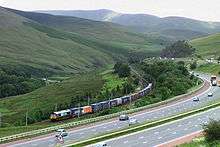River Lune
| River Lune | |
 | |
| Country | England |
|---|---|
| Counties | Cumbria, Lancashire |
| Source | |
| - location | Wath, Ravenstonedale, Cumbria |
| Mouth | |
| - location | Plover Scar, Lancaster, Lancashire |
| - coordinates | 53°59′6″N 2°52′39″W / 53.98500°N 2.87750°WCoordinates: 53°59′6″N 2°52′39″W / 53.98500°N 2.87750°W |
| Length | 71 km (44 mi) |
| Wikimedia Commons: River Lune | |
The River Lune (archaically sometimes Loyne) is a river in Cumbria and Lancashire, England.
The river is formed at Wath, in the parish of Ravenstonedale, Cumbria, at the confluence of Sandwath Beck and Weasdale Beck. It then passes the remnants of a Roman fort near Low Borrowbridge at the foot of Borrowdale, and flows through south Cumbria, meeting the Irish Sea at Plover Scar near Lancaster, after a total journey of about 44 miles (71 km).
The valley of the Lune has three parts. The northern part between its source and Tebay is called Lunesdale. Below this is the spectacular Lune Gorge through which both the M6 motorway and the West Coast Main Railway Line run. Below the gorge, the valley broadens out into Lonsdale.
Bridges over the Lune include the Devil's Bridge near Kirkby Lonsdale and the Lune Millennium Bridge in Lancaster. At Caton, about 5 miles (8 km) upstream from Lancaster, there is a cluster of three bridges (one stone road bridge and two disused iron rail bridges now used as foot/cyclepaths) at the Crook o' Lune. Here in a 180-degree right-hand bend the Lune turns back on itself; this is followed by a 90-degree left-hand bend forming the shape of a shepherd's crook and creating a beauty spot which was painted by J. M. W. Turner.[1]
Near the end of the non-tidal reach of the river stands the Lune Aqueduct, which carries the Lancaster Canal. The Lune is now tidal only below Skerton Weir in Lancaster. Four bridges in close proximity cross the estuary in Lancaster: Skerton Bridge (road), Greyhound Bridge (built as rail but now carries a road), Lune Millennium Bridge (pedestrian and cycle) and Carlisle Bridge (carrying the West Coast Main Line railway, and with a public walkway on the eastern side) which is the furthest downstream of the bridges. A Lancaster western bypass has been under discussion for many years. If it ever proceeds, a new bridge would be built downstream from Carlisle bridge.
This part of the Lune is also the site of the old Port of Lancaster, probably a port from Roman times; the Lancaster Port Commission was established in 1750[2] to improve navigation on the estuary. Between 1750 and 1767, St George's Quay and New Quay were built in Lancaster and in 1779 the port facilities were extended closer to the Irish Sea at Glasson Dock. In 1847 the Commissioners built a pair of lighthouses near Cockersand Abbey to help guide ships into the port. The lower lighthouse, known as the Plover Scar Lighthouse, (sometimes called Abbey lighthouse) still stands on Plover Scar, and it remains operational. The old high light, a square wooden tower, was demolished in 1954; but the former keepers' cottage, built alongside the high light, can still be seen.[3]
Lancaster (and hence also Lancashire) is named after the Lune. The name of the ancient hundred of Lonsdale is also derived from the river. The river is a County Biological Heritage Site.
Etymology
There are these theories about the name "Lune":
- From a Romano-British word meaning "clean", "pure".
- Via Anglo-Saxon Ēa Lōn (ēa = "river") as a phonetic adaptation of a Romano-British name referring to a Romano-British god Ialonus who was worshipped in the area.[4]
- Lune is the crescent shape of the oxbow in the river. Lune is generic for a river with prominent oxbow.
Gallery
 A November Morn in the Lune Valley by Reginald Aspinall
A November Morn in the Lune Valley by Reginald Aspinall- Devil's Bridge over the River Lune in Kirkby Lonsdale
 Near the mouth of the Lune, at Sunderland Point
Near the mouth of the Lune, at Sunderland Point Lune at the Lune Millennium Bridge, with Lancaster in background
Lune at the Lune Millennium Bridge, with Lancaster in background Disused railway bridge at the Crook o' Lune, once part of the "little" North Western Railway, now a cycle path[5]
Disused railway bridge at the Crook o' Lune, once part of the "little" North Western Railway, now a cycle path[5] Lune Gorge
Lune Gorge
Tributaries
|
|
|
|
Notes
| Wikimedia Commons has media related to River Lune. |
- ↑ Crook of Lune, Looking towards Hornby Castle, Tate Collection, accessed 2009-08-15
- ↑ http://www.lancs.ac.uk/depts/cnwrs/papers%20on%20the%20web/arch%20conf%20synopses%201996.rtf Dalziel N., The Port of Lancaster in the 18th Century, University of Lancaster - Archaeology Conference 2 March 1996
- ↑ Photo and details
- ↑ Ian G. Smith, Some Roman Place-names in Lancashire and Cumbria, Britannia xxix (1998), 372-383
- ↑ "Crook O' Lune bridge repairs start". BBC News Online. 18 March 2013.